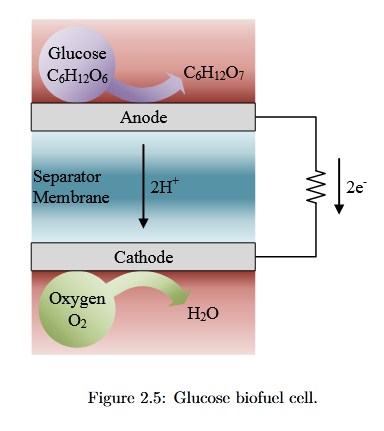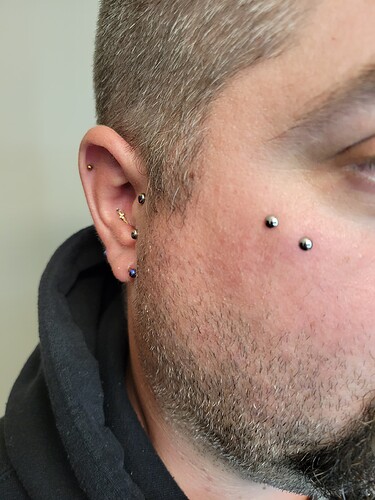Is that bad, doctor ? ![]()
![]()
You’re probably right one this one. Yet I feel like chemistry is the way to go for energy harvesting in vivo, there must be a way ![]()
Yeah, the body manages to move energy around so how do we tap into that mechanism?
Vampire chips ![]()
Edit: are we going into symbiote territory here? Love it ![]()
One way to “tap into” the goth market.
You could also promote them as a weight loss plan… “Crank it up and shed the pounds”.
The only reliable mechanism that I’ve heard of that could harvest chemical energy from the body without significantly impacting health are glucose biofuel cells
Check out this thesis
I still think doing so is silly when RF energy harvesting is so efficient. You just have to deal with maintenance of the external source, but I’m fine with that. That’s why I’m here.
Is there a way to embed a chip with a capacitor inside a dermal piercing post? And then use the posts on a magnetic usb charger? Every time I look at my piercing it reminds me of an old device I had that had a magnet charging port. Don’t know if this would work just had a thought when I was looking in the mirror lol.
I think the general trend was dermals weren’t trusted due to possibly becoming infected or ripping out
I think it would be sweet if those could be ironed out
There is the matter that your flesh is conductive, so you’d need to insulate it
![]()
Last I heard, caps weren’t working out very well
Though
![]() , I have a couple devices that also use magnets to charge, to help them remain water proof
, I have a couple devices that also use magnets to charge, to help them remain water proof
This project is possible anyone want to work with it, this is similar to LED tattoo.
An LED tattoo is a type of body modification similar to a traditional tattoo, but it involves the implantation of technologically based materials instead of traditional ink injection into the layers of the skin. LED tattoos are accomplished by a combination of silicon-silk technology and a miniature lighting device known as a light-emitting diode. While there is potential for many applications in the medical, commercial, and personal domains, the technology is still in the development stage
Links and resources:
https://edm.com/gear-tech/led-tattoos-light-up-with-rave-visuals
Well hello, I haven’t encountered you yet. What would you like to do?
Hello @Satur9 I had my chip implant last year and having a blast since having it, showing off to my friends/family/social media, etc. using it as 2-auth, password, ,launching apps, storing information’s, BTC address etc. I’ve been checking out your projects like Bodybytes Implant - #107 by Pilgrimsmaster and HF LED Power Accessories and also this one, and I would like to help you guys out!
How would you like to help out? Is there a specific project that interests you more than the others, and what type of skills or resources can you bring to the table?
I’m a software/system engineer also a cyber-security & penetration tester (grey-hat), I’m very interested with those 3 projects also my aunt company international logistics a registered partner of IBM, I got of tech connection in linkedin but it’s permanently restricted. I can also bring in investors and money if those projects are successful.
The way around some of these response related issues; may be to collaborate with the working group responsible for the company itself.
Hey, just reading about this project for the first time, seems very cool. I may have an alternative approach though; So i have thought about how cool it would be to have programmable tatoos before, and one possible solution that came to my mind were e-paper displays, or rather their underlying principle. Basically they have electrostatically charged white and black ink droplets, suspended in oil (-cells). By applying an electric field you can change what colour is near the surface.
For skin implants you would need to encapsulate everything in a small glass (or similar) bead, so the ink doesn’t come into direct contact with the body. Alternatively you could also use magnetic spheres or discs with two coloured sides, also in a glass sphere so it can easily rotate. To use it as a clock, you would need to have a flexible pcb to generate the magnetic or electric fields. If you use magnetic fields it might not even require a lot of power, since you could make it an oscillating circuit with a capacitor, only using up little energy rotating the magetic spheres. It might still be a bit high though. But a fun observation i have made, is that electric power in houses often produces 60Hz magnetic fields, which you can even measure with a multimeter by touching both ends with your fingers sometimes. I imagine that induction could be used to power implants, using a long enough coil/antenna.
Ah nice, thanks. But i thought of applying the colour beads by tatooing them, allowing them to be way closer to the surface. It should also be easy to “program” them externally, that would however not work for a clock or similar though.
Let’s continue this line of discussion on the eink tattoo thread instead ![]()
I was really into this project and had a breadboard prototype but gave up because I couldn’t get any betavoltaic suppliers to take me seriously, but that might change?
I’m sure it’s being sensationalised but if this company doesn’t make them easily available then maybe someone else will soon with all the media attention
I’ve been trying to get ahold of those for a few months, they were announced last year. I have a couple friends who go to Shenzhen semi regularly and they’re looking for me. We’ll see. Those are ideal because they’re Nickel-63. I’m still interested in a solution involving hybrid supercapacitors, I just haven’t had the money or bandwidth to continue development yet


